

Hellenistic philosophy and Christianity. Pythagorean mysticism influenced Christianity.

Hellenistic philosophy and Christianity refers to the complex interaction between Hellenistic philosophy and early Christianity during the first four centuries AD. The conflict between the two modes of thought is recorded in Paul's encounters with Epicurean and Stoic philosophers in Acts 17:18, his diatribe against Greek philosophy in 1Corinthians 1:18-31 and his warning against philosophy in Colossians 2:8. However, as Christianity spread throughout the Hellenic world, an increasing number of church leaders were educated in Greek philosophy. The dominant philosophical traditions of the Greco-Roman world at the time were Stoicism, Platonism, and Epicureanism. Stoicism and particularly Platonism were readily incorporated into Christian ethics and Christian theology.
Christian assimilation of Hellenic philosophy was anticipated by Philo and other Greek-speaking Alexandrian Jews. Persephone. Persephone as a vegetation goddess and her mother Demeter were the central figures of the Eleusinian mysteries that predated the Olympian pantheon and promised the initiated a more enjoyable prospect after death.

Persephone is further said to have become by Zeus the mother of Dionysus, Iacchus, or Zagreus, usually in orphic tradition. The origins of her cult are uncertain, but it was based on very old agrarian cults of agricultural communities. Hippolyta. Dionysus. The earliest cult images of Dionysus show a mature male, bearded and robed.
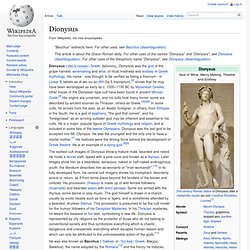
He holds a fennel staff, tipped with a pine-cone and known as a thyrsus. Later images show him as a beardless, sensuous, naked or half-naked androgynous youth: the literature describes him as womanly or "man-womanish".[10] In its fully developed form, his central cult imagery shows his triumphant, disorderly arrival or return, as if from some place beyond the borders of the known and civilized. His procession (thiasus) is made up of wild female followers (maenads) and bearded satyrs with erect penises. Some are armed with the thyrsus, some dance or play music. Greco-Roman mysteries. See Western esotericism for modern "mystery religions" in the Western cultural sphere.
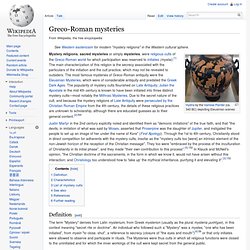
Definition[edit] The term "Mystery" derives from Latin mysterium, from Greek mysterion (usually as the plural mysteria μυστήρια), in this context meaning "secret rite or doctrine". An individual who followed such a "Mystery" was a mystes, "one who has been initiated", from myein "to close, shut", a reference to secrecy (closure of "the eyes and mouth")[4]:56 or that only initiates were allowed to observe and participate in rituals. Demeter. In ancient Greek religion and myth, Demeter (/diˈmiːtər/; Attic: Δημήτηρ Dēmḗtēr; Doric: Δαμάτηρ Dāmā́tēr) is the goddess of the harvest, who presided over grains and the fertility of the earth.
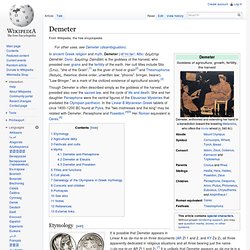
Her cult titles include Sito (Σιτώ), "she of the Grain",[1] as the giver of food or grain[2] and Thesmophoros (θεσμός, thesmos: divine order, unwritten law; "phoros": bringer, bearer), "Law-Bringer," as a mark of the civilized existence of agricultural society.[3] Etymology[edit] Demeter's character as mother-goddess is identified in the second element of her name meter (μήτηρ) derived from Proto-Indo-European *méh₂tēr (mother).[11] In antiquity, different explanations were already proffered for the first element of her name. Folklore. A magic carpet - a carpet that can allegedly transport persons instantaneously or swiftly to a destination.
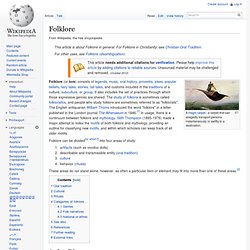
Folklore can be divided[by whom?] Into four areas of study: artifacts (such as voodoo dolls)describable and transmissible entity (oral tradition)culturebehavior (rituals) These areas do not stand alone, however, as often a particular item or element may fit into more than one of these areas.[2] Oral tradition[edit] While folklore can contain religious or mythic elements, it equally concerns itself with the sometimes mundane traditions of everyday life. Fled Bricrenn. Fled Bricrenn (Old Irish "Bricriu's Feast") is a story from the Ulster Cycle of Irish mythology.
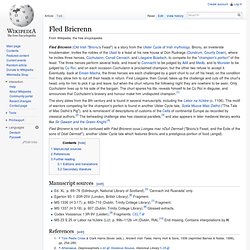
Celtic mythology. Overview[edit] Though the Celtic world at its apex covered much of western and central Europe, it was not politically unified nor was there any substantial central source of cultural influence or homogeneity; as a result, there was a great deal of variation in local practices of Celtic religion (although certain motifs, for example the god Lugh, appear to have diffused throughout the Celtic world).
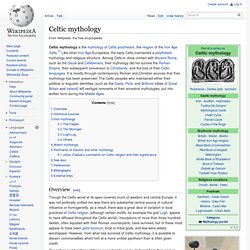
Inscriptions of more than three hundred deities, often equated with their Roman counterparts, have survived, but of these most appear to have been genii locorum, local or tribal gods, and few were widely worshipped. However, from what has survived of Celtic mythology, it is possible to discern commonalities which hint at a more unified pantheon than is often given credit. Girdle. A woman's girdle (in pink).
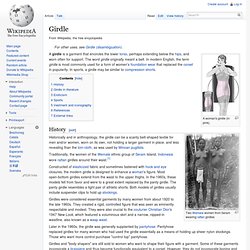
A girdle is a garment that encircles the lower torso, perhaps extending below the hips, and worn often for support. The word girdle originally meant a belt. In modern English, the term girdle is most commonly used for a form of women's foundation wear that replaced the corset in popularity. In sports, a girdle may be similar to compression shorts.
History[edit] Sir Gawain and the Green Knight. Jesus Christ in comparative mythology. The study of Jesus Christ in comparative mythology is the examination of the narratives of the life of Jesus in the Christian gospels, traditions and theology, as it relates to Christian mythology and other religions.
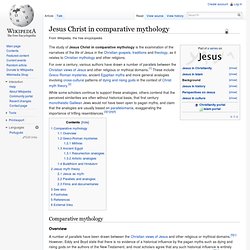
For over a century, various authors have drawn a number of parallels between the Christian views of Jesus and other religious or mythical domains.[1] These include Greco-Roman mysteries, ancient Egyptian myths and more general analogies involving cross-cultural patterns of dying and rising gods in the context of Christ myth theory.[2] While some scholars continue to support these analogies, others contend that the perceived similarities are often without historical basis, that first century monotheistic Galilean Jews would not have been open to pagan myths, and claim that the analogies are usually based on parallelomania, exaggerating the importance of trifling resemblances.[3][1][4][5] Comparative mythology Overview Greco-Roman mysteries E.
Chthonic.